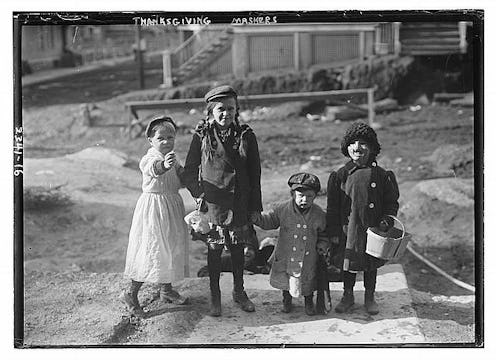Life
Thanksgiving Used to Be Kind of... Weird

Are you still mourning the fact that you have to wait another year before you get to dress up for Halloween? As it turns out, if you'd been born in the early 1900s, you wouldn't have to, because Thanksgiving used to look a lot like Halloween. Americans are kinda weird sometimes, if you didn't know that already. While they didn't quite go for the Mean Girls "lingerie plus animal ears" method, back in the early 20th century people treated Thanksgiving much like we do Halloween now. According to photographs unearthed from the Library of Congress by NPR, people wore papier-mache masks and colorful costumes to take to the streets just like we do now with trick-or-treating — or, if they had well-off friends, they attended masked balls. (That one might just be because rich people will take any excuse to throw a masquerade, though.) Giant false hands and feet and bird costumes were inexplicably popular, and because this was America, a lot of the costumes were totally offensive. Think costumes that "exaggerated the facial features of other countries." In fact, so many kids dressed up as poor people that Thanksgiving also became known as "Ragamuffin Day" for a while. Man, people really don't change
The kids who dressed up as beggars would go around town asking for money, usually getting an apple or a piece of candy in response. Some adults would dress up like well-known political figures of the time, much like today or, if they were especially classy, wear a snazzy veil to hide their face. Who knew Thanksgiving could be so incredibly creepy?
Seriously, these are going to give me nightmares. Why did old-timey masks have to be so terrifying?
The tradition of dressing up and begging for candy on Thanksgiving eventually petered out around the 1930s, probably because giving out candy to creepy-looking kids and even creepier adults once a year is quite enough. But hey, why not bring back the tradition? Wearing a giant mask would give you something to talk about with that awkward distant relative you're forced to sit next to at Thanksgiving this year.Images: Library of Congress